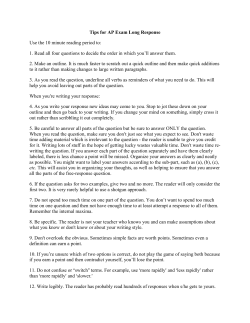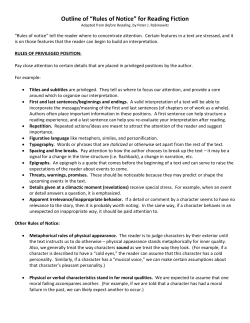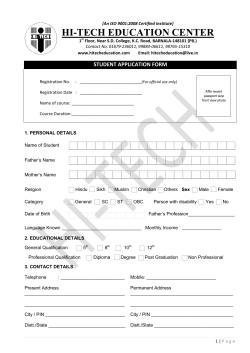
Elements of Effective Layout
Elements of Effective Lay=--o_u_t
orothy Cohen
Dorothy Cohen (J915-) was educated at Hunter College,
City University of New rork, Columbia University, and
New York University, where she received a Ph.D. in 1966.
She has been a public school teacher in New rork City and
a professorofeducation at Long Island University. She has
also been a senior staffmember at the Bank Street College
ofEducation in New rork. As a noted educator and child
development specialistshe has published, most notably, The
Learning Child: Guidelines for Parents and Teachers
(J988). She has also written on the subject ofadvertising
and marketing, including Consumer Behavior (I981),
and Legal Issues in Marketing Decision Making (I994).
The fOllowing selection is taken from Advertising (I 988).
F
undamentally a good layout should attract attention and
interest and should provide some control over the manner in
which the advertisement is read. The message to be communi
cated may be sincere, relevant, and important to the consumer, but
because of the competitive "noise" in the communication channel,
the opportunity to be heard may depend on the effectiveness of the
layout. In addition to attracting attention, the most important requi
sites for an effective layout are balance, proportion, movement, unity,
clarity and simplicity, and emphasis.
Balance
Balance is a fundamental law in nature and its application to layout
design formulates one of the basic principles of this process. Balance
Reprinted from Advertising, by perm ission of Pearson Educ ation . Copyright © 1988
by Dorothy Cohen .
123
_
c;O I'1t:N
1 1"
1"'1 1 ~I
l "l I
If 1 111 ' 11Vl 1 A
TI 1(
or WCII',III di ,'ilrihllll(lll: III 1.11'(1111 II I', \(1'1"'.1 I,) the o/,/il'tll
or an advcn iscmcnt > I1lc I)oilll wh n 111111' 1\' ,111",,',\ eye dcsignates
as the center of an area, In all advt'l'tiselll('111 :1 vcrt ical liuc which
divides the area into right and kJI halvl'S <olltains Ihl' cent er: however
the optical center is between one-tenth and one-third the distance
above the mathematical horizontal center line, , , .
In order co provide good artistic composition, the elements in the
layout must be in equilibrium. Equilibrium can be achieved through
balance, and this process may be likened to the balancing of a seesaw.
The optical center of the advertisement serves as the fulcrum or bal
ancing point, and the elements may be balanced on both sides of this
fulcrum through considerations of their size and ronal quality.
The simplest way to ensure formal balance between the elements
co the right and left of the vertical line is to have all masses in the left
duplicated on the right in size, weight, and distance from the cen
ter. . . . Formal balance imparts feelings of dignity, solidity, refine
ment, and reserve. It has been used for institutional advertising and
suggests conservatism on the part of the advertiser. Its major defi
ciency is that it may present a static and somewhat unexciting appear
ance; however, formal balance presents material in an easy-co-follow
order and works well for many ads.
To understand informal balance, think of children of unequal
weight balanced on a seesaw; to ensure equilibrium it is necessary to
place the smaller child far from the center and the larger child closer
to the fulcrum. In informal balance the elements are balanced, but
not evenly, because of different sizes and color contrast. This type of a
symmetric balance requires care so that the various elements do not
create a lopsided or top-heavy appearance. A knowledge or a sense of
the composition can help create the feeling of symmetry in what is
essentially asymmetric balance.
Informal balance presents a fresh, untraditional approach. It creates
excitement, a sense of originality, forcefulness, and, to some extent, the
element of surprise. Whereas formal balance may depend on the high
interest value of the illustration to attract the reader, informal balance
may attract attention through the design of the layout. . , .
is
<I
u n '....... I
Ir
I I I I II I I I
• \, .,1' 1 I I
'
I ~'
I I V I
1. ( "
....... ~ .... 1
spacc ill,d 111\' 1'11\1111 .1>.1>, 10 h, , I I \ 'i1.!ed \"11 II e!cllll:lll, l'roporuou, [0
t lrc advcn ixin]; .11':,11',11\'1 , 1.\ Ih,' 1(-!;IIIOIISI,ip between the size of one
clement in t hc ad to .nrot hcr, 111\' .uuouut of space between elements,
as well as the wicl:h or the toral ad to its depth. Proportion also
involves the tone of the ad : [he amount of light area in relation to
dark area and the amount of color and noncolor.
As a general rule unequal dimensions and distances make the
most lively design in advertising. The designer also places the ele
ments on the page so that each element is given space and position in
proportion to its importance in the total advertisement and does not
look like it stands alone.
m .u nr
(ttl/a
Movement
III
If an advertisement is to appear dynamic rather than static, it must
contain some movement. Movement (also called sequence) provides
the directional flow for the advertisement, gives it its follow-through,
and provides coherence. It guides the reader's eye from one element to
another and makes sure he or she does not miss anything.
Motion in layout is generally from left to right and from top co
bottom-the direction established through the reading habits of
speakers of Western language. The directional impetus should not
disturb the natural visual flow but should favor the elements to be
stressed , while care should be taken not to direct the reader's eye out
of the advertisement. This can be done by the following:
• Gaze motion directs the reader's attention by directing the looks
of the people or animals in an ad. If a subject is gazing at a unit
in the layout, the natural tendency is for the reader CO follow
the direction of that gaze; if someone is looking directly out of
the advertisement, the reader may stop co see who's staring.
• Structural motion incorporates the lines of direction and pat
terns of movement by mechanical means. An obvious way is co
use an arrow or a pointed finger....
Unity
Proportion
Proportion helps develop order and creates a pleasing impression. It is
related to balance but is concerned primarily with the division of the
Another important design principle is the unification of the layout.
Although an advertisement is made up of many elements, all of these
should be welded into a compact composition. Unity is achieved
124
125
10
Ity' lI'l
Questions on
wlicu 1I11' ('kllll'III S lil' jlllil IIIIl' ,11 1111 11, ' 1 1,1' II,-,i I 'I', t l u: x.u u c basic
shapcs, si:t.cs, te xtures, color», alld 111ClCld . III addil.ioll. IIll' Iypl' sho uld
have the same character as I he art,
A bordersurro und ing an ad provides a method of' achi eving uniry.
Sets of borders may occur within an ad , and , when they are similar in
thickness and tone, they provide a sense of unity.
Effective use of white space can help to establish unity. . . . White
space is defined as th at part of the advertising space whi ch is not occu
pied by any other elements; in this definition , white space is not
always white in color. White space may be used to feature an impor
tant element by setting it off, or to imply luxury and prestige by pre
venting a crowded appearance. It may be used to direct and control
the reader's attention by tying elements together. If white space is
used incorrectly, it may cau se separatio n of the elements and create
difficulty in viewing the advertisement as a whole.
" .I\ .J I
Ml~;lUin~
I. In one SCIH l' I Il (' pCI' IIIl' fj)lIC1willl!. 1l'1I1lS, define balance, proportion,
movement, unity, «l.uu y, silllillici,y, and emphasis.
2. What is the difTl'rt'ncl' between formal and informal balan ce?
:~ . What is the significance of mov ement to effective graphic design?
How can unity be achieved?
Questions on Rhetorical Strategy and Style
I . This selectio n is written in typical textbook style. How would you
characterize it?
2. What information does the author supply to help the reader under
stand these elements? What might the author have included that
she did not, in yo ur opinion?
3. What visual cues helped your reading of this selection?
Clarity and Simplicity
Writing Assignments
The good art director does not permit a layout to become too cornpli
cared or tricky. An advertisement should retain its clarity and be easy to
read and easy to understand. The reader tends to see the total image of
an ad vert isement; thu s it should not appear fussy, contrived, or confus
ing. C o lo r contrasts, including tones of gray, should be stro ng enough
to be easily deciphered , and the various units should be clear and easy
to understand. Type size and design should be selected for ease of read
ing, and lines of type should be a comfortable reading length. Too
many units in an advertisement are distracting, therefore, any elernents
that can be eliminated without destroying the message should be. One
way in which clarity can be achieved is by combining the logo, trade
mark, tag lin e, and company name into one compact group.
1. Test your understanding of these terms by choosing an ad and
analyzing it accordingly. Which elements were you able to apply
most readily? Which proved most difficult?
2. Explain in an essay what the author means by balance. How is
balance "a fundamental law in nature"? In yo ur essay, detail
examples of wh ere this concept appears to hold true.
Emphasis
15
rv
Although varying degrees of emphasis may be given to differem elemerits, one unit should dominate. It is the designer's responsibility to
determine how much em phasis is necessary, as well as how it is to be
achieved. The important element may be placed in the optical center or
removed from the clutter of other elements. Emphasis may also be
achieved by contrasts in size, shape, and color, or the use of white space.
126
15
127
© Copyright 2025
![Dear [Insert Employers Name] I`m writing with regards to your](http://cdn1.abcdocz.com/store/data/001085065_1-b5c2ea463943ed18cfa6b628c4be74eb-250x500.png)








